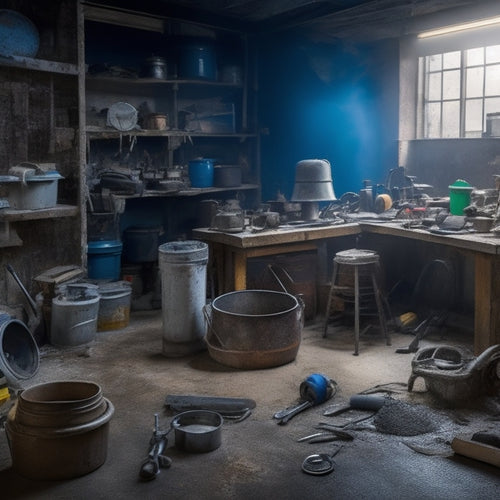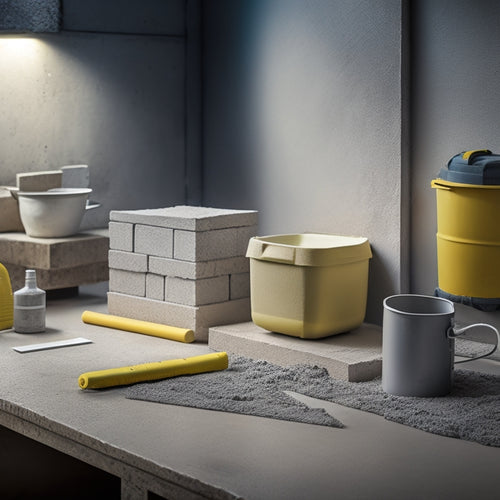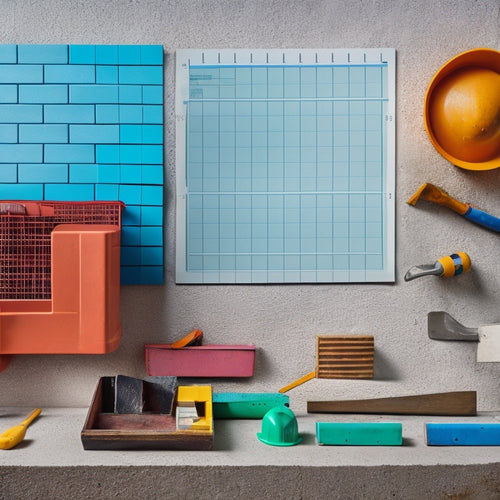
Essential Tools for Concrete Wall Waterproofing
Share
When it comes to concrete wall waterproofing, you'll need a range of essential tools and techniques to guarantee a watertight seal. Start with surface preparation tools like scarifying equipment and grinding machinery to create a smooth surface. For crack repair, you'll require epoxy-based injection systems, polyurethane foam injections, and specialized saws. Don't forget waterproof coating application tools, drainage system installation equipment, and joint sealing materials. Additionally, invest in testing and inspection equipment, such as moisture meters and infrared thermography cameras, to monitor wall conditions. With the right tools and techniques, you'll be well on your way to achieving a reliable waterproofing system; now, let's take a closer look at each of these critical components.
Key Takeaways
• Concrete surface preparation tools, such as power washing and scarifying equipment, are essential for effective cleaning and preparation.
• Crack repair and injection tools, including epoxy-based and polyurethane foam systems, are necessary for addressing fine hairline cracks and larger voids.
• Waterproof coating application requires proper surface preparation, cleaning methods, and moisture barrier evaluation to ensure a strong bond and successful application.
• Drainage system installation and design involve directing water away from concrete walls using perforated pipes, sump pumps, and proper sloping to prevent accumulation.
• Testing and inspection equipment, including moisture meters, infrared thermography cameras, and substrate analysis kits, are crucial for detecting potential weaknesses and ensuring waterproofing effectiveness.
Concrete Surface Preparation Tools
You'll need a range of concrete surface preparation tools to guarantee the surface is clean, dry, and free of defects before applying a waterproofing system. This is a critical step, as any imperfections can compromise the effectiveness of the waterproofing system.
To achieve a suitable surface, you'll employ surface cleaning techniques, such as power washing or acid etching, to remove dirt, oil, and other contaminants.
Next, you'll use substrate evaluation methods, like delamination testing or pull-off testing, to assess the concrete's integrity and identify any defects. These methods help you identify areas that require repair or replacement before applying the waterproofing system.
Additionally, you may need to use scarifying tools to remove laitance or other weak layers, or use grinding equipment to achieve a smooth, even surface.
Crack Repair and Injection
As you move forward with crack repair and injection, you'll need to address fine hairline cracks that can compromise the integrity of your concrete wall.
You'll have to decide between epoxy-based injection systems and polyurethane foam injections, each with its own strengths and weaknesses.
Sealing Fine Hairline Cracks
Sealing fine hairline cracks requires a thorough understanding of the crack repair and injection process to prevent further damage and water ingress.
As you assess the concrete wall, you'll need to identify the hairline cracks, which can be challenging due to their small size. Hairline crack identification involves a visual inspection, and in some cases, may require specialized equipment to detect the cracks.
To effectively seal these cracks, you'll need to employ the right sealing techniques. Here are three essential tools to take into account:
-
Crack chasing saws: These saws are designed to widen the crack, allowing for a more effective seal.
-
Epoxy-based sealants: These sealants are ideal for hairline cracks, as they provide a strong and flexible bond.
-
Injection ports: These ports enable you to inject sealants directly into the crack, ensuring a thorough seal.
When selecting a sealing technique, reflect on the crack's width, depth, and location.
Epoxy-Based Injection Systems
With epoxy-based sealants playing a key role in effectively sealing fine hairline cracks, epoxy-based injection systems offer a more extensive solution for crack repair and injection in concrete walls.
When you're dealing with larger cracks or more extensive damage, epoxy-based injection systems provide a robust solution. These systems involve injecting a specialized epoxy resin into the crack or damaged area, which then hardens to form a strong, durable bond. The epoxy advantages in this instance include high compressive strength, excellent adhesion, and resistance to chemicals and water.
When using epoxy-based injection systems, you'll need to employ specific injection techniques to guarantee effective repair. This typically involves drilling holes at an angle into the crack, then injecting the epoxy resin under pressure.
The resin flows through the crack, filling any voids and gaps, and then hardens to create a solid, watertight seal. By following proper injection techniques and using high-quality epoxy-based injection systems, you can achieve a long-lasting, reliable repair that effectively waterproofs your concrete wall.
Polyurethane Foam Injections
When tackling larger cracks or voids in concrete walls, you'll turn to polyurethane foam injections, a versatile crack repair and injection method that expands to fill gaps and hardens to form a durable, watertight seal. This method is particularly effective for cracks that are too large for epoxy-based injection systems.
Here are three key benefits of polyurethane foam injections:
-
Flexibility: Polyurethane foam can expand up to 20 times its original volume, making it an ideal solution for filling large voids and cracks.
-
Water resistance: Polyurethane properties guarantee that the foam remains watertight, even when exposed to water or high humidity.
-
Long-term durability: Once hardened, the polyurethane foam forms a strong, long-lasting bond with the surrounding concrete, providing a reliable seal that can withstand environmental stressors.
When applying polyurethane foam, it's important to follow proper foam application techniques to guarantee a successful repair. This includes cleaning the crack or void, preparing the injection site, and carefully injecting the foam to avoid over- or under-filling.
Waterproof Coating Application
As you begin applying a waterproof coating to your concrete wall, you'll need to choose the right coating material for the job, considering factors like durability, adhesion, and compatibility with the wall's surface.
Proper surface preparation is also essential, and you'll need to decide on the best method for cleaning and priming the wall to guarantee a strong bond between the coating and the concrete.
Coating Material Selection
You must carefully select a coating material that meets the specific requirements of your concrete wall waterproofing project, considering factors such as surface preparation, environmental exposure, and desired performance. This decision is essential, as it directly impacts the effectiveness and longevity of your waterproofing system.
When choosing a coating material, consider the following key factors:
-
Waterproof coating types: Select from a range of options, including acrylic, polyurethane, epoxy, and silicone-based coatings, each with its own strengths and weaknesses.
-
Moisture barrier options: Decide between sheet-applied membranes, fluid-applied membranes, and cementitious coatings, depending on your project's specific needs.
-
Environmental exposure: Consider the level of exposure to water, sunlight, and chemicals your wall will face, and choose a coating material that can withstand these conditions.
Surface Preparation Methods
Before applying a waterproof coating, thoroughly clean and prepare the concrete surface to guarantee a strong bond between the coating and the wall.
You'll need to remove dirt, oil, and other contaminants that can compromise the coating's adhesion. Effective surface cleaning techniques include power washing, sandblasting, or using a wire brush to remove loose particles. Additionally, evaluate the surface for signs of cracks, holes, or other damage that may require repair before applying the coating.
Next, conduct a moisture barrier evaluation to verify the surface is dry and free of excess moisture. This step is critical, as trapped moisture can cause the coating to fail. Use a moisture meter to test the surface's moisture levels, and apply a drying agent if necessary.
Once the surface is clean and dry, you can proceed with applying the waterproof coating. Remember to follow the manufacturer's instructions for surface preparation and coating application to verify a successful waterproofing job.
Drainage System Installation
Installing a drainage system behind the concrete wall is essential to direct water away from the wall and prevent water accumulation. As you plan to waterproof your concrete wall, you'll need to confirm that you have a functional drainage system in place. This involves installing a drainage pipe behind the wall to collect and redirect water away from the structure.
Here are three key components to evaluate when installing a drainage system:
-
Drainage pipe installation: This involves laying a perforated pipe behind the wall to collect water that seeps through the concrete. The pipe should be sloped to allow water to flow towards a collection point.
-
Sump pump systems: A sump pump is used to pump collected water away from the wall and dispose of it safely. You'll need to choose a pump that's suitable for your specific needs, taking into account factors like flow rate and pressure.
-
Proper drainage design: The drainage system should be designed to handle the expected water flow and pressure. This includes confirming that the pipe is large enough to handle the volume of water and that the system is properly sloped to prevent water accumulation.
Sealing Joints and Cracks
With a functional drainage system in place, the next step in concrete wall waterproofing is to seal joints and cracks to prevent water infiltration through these vulnerable areas.
You'll need to employ effective joint sealing techniques to guarantee a watertight seal. This involves selecting the right sealant material, preparing the joint surface, and applying the sealant according to the manufacturer's instructions.
When it comes to cracks, you'll need to implement a crack monitoring system to detect and address any cracks that develop over time. This may involve installing sensors or monitoring devices to track changes in the crack width or depth. By doing so, you can identify potential issues before they lead to water infiltration.
To seal cracks, you'll need to use a suitable crack injection material, such as epoxy or polyurethane, that's designed for concrete repair. It's crucial to follow the manufacturer's guidelines for application and curing times to guarantee a successful seal.
Testing and Inspection Equipment
You'll need to utilize specialized testing and inspection equipment to verify the effectiveness of your concrete wall waterproofing efforts and identify any potential weaknesses or defects. This equipment helps you detect issues before they become major problems, ensuring a watertight seal and preventing costly repairs down the line.
Here are three essential tools to include in your arsenal:
-
Moisture meters: These devices measure the moisture levels in your concrete walls, allowing you to identify areas where water may be seeping in.
-
Infrared thermography cameras: These cameras detect temperature anomalies in your walls, which can indicate moisture presence or energy loss.
-
Substrate analysis kits: These kits enable you to collect and analyze samples of your wall's substrate, helping you identify potential weaknesses or defects that could compromise your waterproofing efforts.
Protective Gear and Accessories
As you move forward with concrete wall waterproofing, don't overlook the importance of wearing protective gear and using accessories that safeguard your health and guarantee a successful application process. Inhaling dust and debris, or getting chemicals in your eyes, can be hazardous to your health. To avoid these risks, make certain you have the following essential protective gear and accessories:
| Protective Gear | Description | Benefits |
|---|---|---|
| Protective Gloves | Waterproof, puncture-resistant gloves | Prevents skin irritation and injuries |
| Safety Goggles | Impact-resistant goggles with anti-fog coating | Protects eyes from chemicals and debris |
| Respirator Mask | Dust mask with filter | Prevents inhalation of dust and debris |
When selecting protective gear and accessories, choose products that meet industry standards and are specifically designed for concrete wall waterproofing applications. Confirm a proper fit, and regularly inspect your gear for signs of wear and tear. By prioritizing your safety, you'll be able to complete the waterproofing process efficiently and effectively.
Frequently Asked Questions
Can I Waterproof a Concrete Wall Without Professional Assistance?
You can attempt to waterproof a concrete wall on your own using DIY methods, but be prepared for potential pitfalls; opting for cost-effective solutions may compromise effectiveness, and improper application can lead to further damage.
How Long Does a Waterproofing Project Typically Take to Complete?
You'll be surprised to know that 75% of homeowners underestimate the time it takes to complete a waterproofing project. Typically, your project timeline will range from a few days to several weeks, depending on factors influencing the scope and complexity of the job.
Are There Any Eco-Friendly Waterproofing Options Available?
You'll be pleased to know that eco-friendly waterproofing options are available, featuring biodegradable sealants and natural additives that reduce environmental impact without compromising performance, offering a guilt-free solution for your project.
Can I Waterproof a Wall That's Already Showing Signs of Damage?
As you face the crumbling facade, don't let it crumble further - first, conduct a thorough damage assessment to identify the root cause, then employ targeted repair techniques to salvage the wall before applying waterproofing measures.
Do I Need to Reapply Waterproofing Coatings Regularly?
You'll need to reapply waterproofing coatings regularly, depending on the coating's durability and environmental factors, to maintain effectiveness; typically, you'll need to reapply every 5-10 years, but this waterproofing frequency may vary.
Conclusion
You've finally reached the end of this concrete wall waterproofing journey, and it's time to holster your tools like a modern-day cowboy securing their trusty revolver.
With these essential tools at your disposal, you're well-equipped to tackle even the most intimidating waterproofing tasks.
Remember, a job well done isn't just about the tools, but the expertise and precision that comes with them.
Now, get out there and start waterproofing like a pro!
Related Posts
-

7 Tools to Fix Damaged Concrete Floors
You're about to tackle that damaged concrete floor, and the right tools are essential for a successful repair. Start ...
-

What Tools Do I Need for Concrete Block Laying
You'll need a thorough set of tools to guarantee accurate, efficient, and professional concrete block laying. Essenti...
-

Reinforcement Tools Checklist for Concrete Block Walls
You'll need a range of reinforcement materials, including horizontal and vertical rebar, fiber mesh, and anchor bolts...


